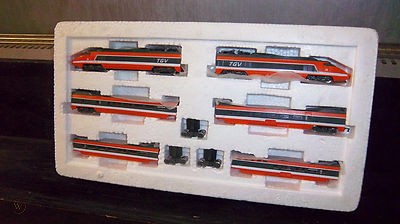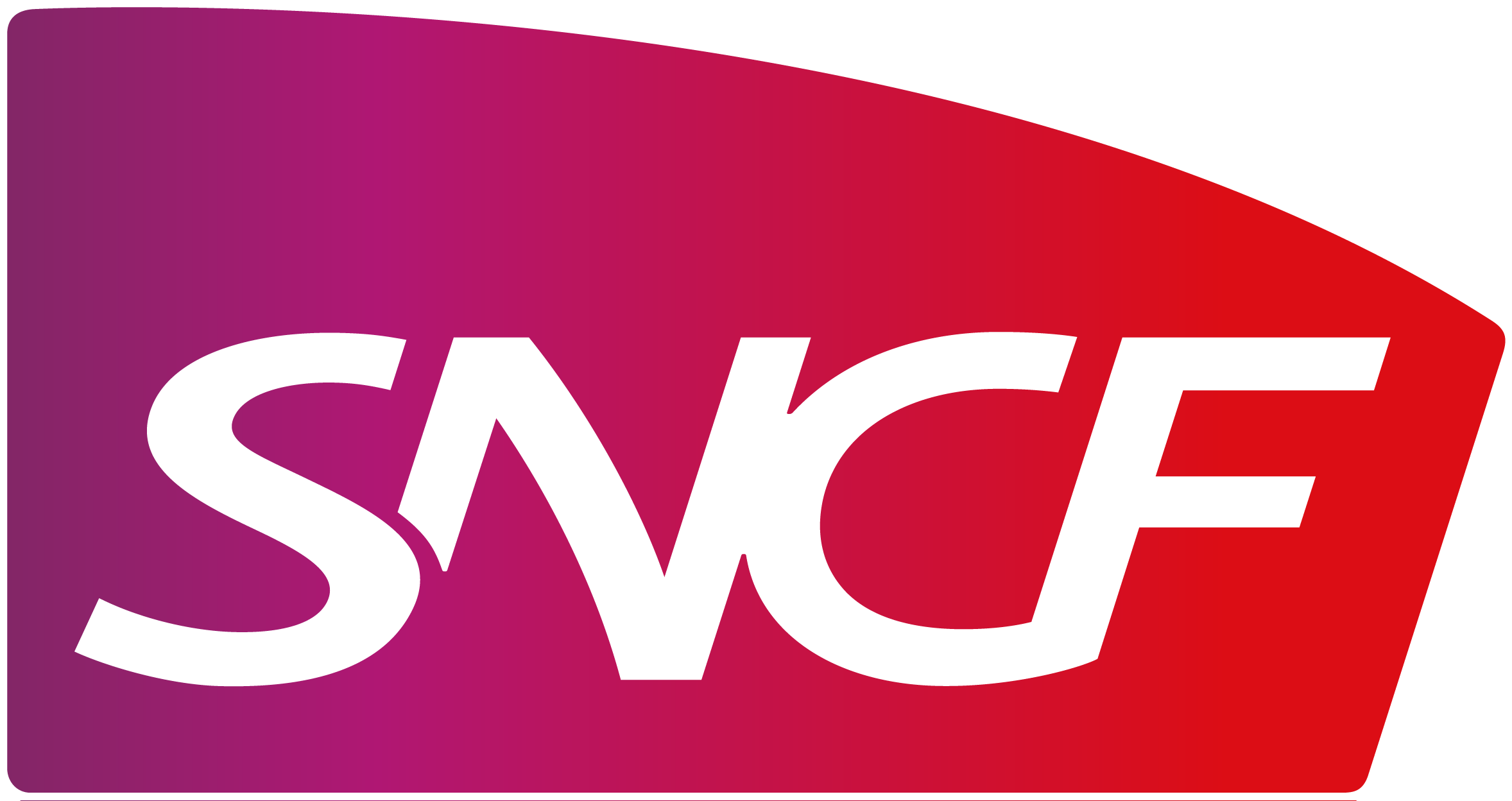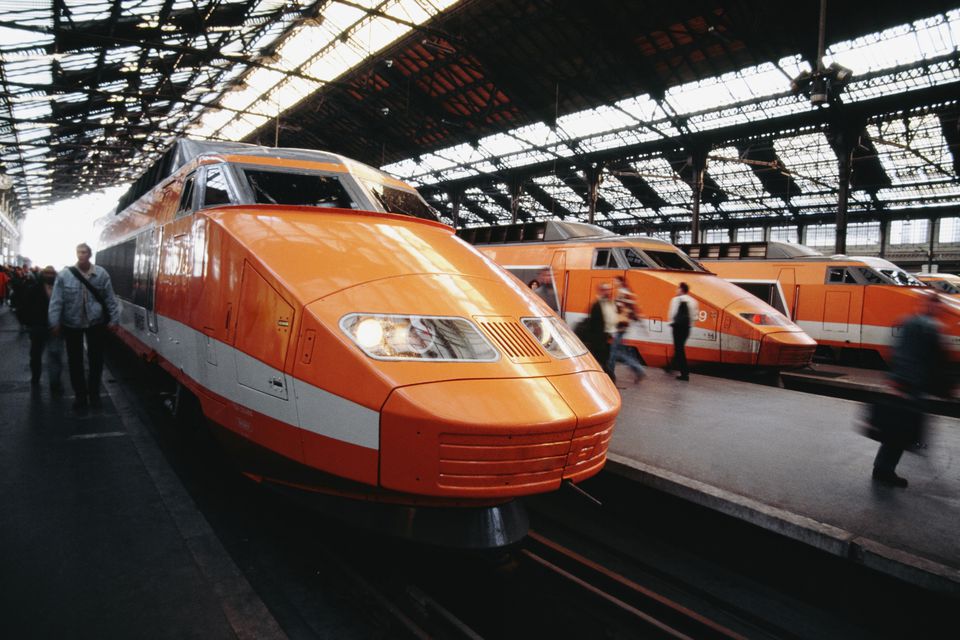Bachmann - 51-4002 - Passenger Train, Electric, TGV - SNCF - 16
| Stock Number | 51-4002 |
| Brand | Bachmann |
| Manufacturer | Bachmann |
| Body Style | Bachmann Train Set |
| Prototype Vehicle | Passenger Train, Electric, TGV (Details) |
| Road or Company Name | SNCF (Details) |
| Reporting Marks | 6-Unit |
| Road or Reporting Number | 16 |
| Paint Color(s) | Orange, White and Gray |
| Print Color(s) | White |
| Paint Scheme | TGV Orange |
| Wheel Type | Nickel-Silver Plated Metal |
| Multipack | Yes |
| Multipack Count | 6 |
| DCC Readiness | No |
| Item Category | Passenger Trains |
| Model Type | Electric |
| Model Subtype | TGV |
| Model Variety | Sud-Est |
| Prototype Region | Europe |
| Prototype Era | EU Epoch V (1985 - 2000) |
| Years Produced | 1981 - Present |
| Scale | 1/160 |
Specific Item Information:
This version of the set has the train only. The set has no track and no power pack.
Prototype History:
The TGV (French: Train à Grande Vitesse, "high-speed train") is France's intercity high-speed rail service, operated by the SNCF, the national rail operator. It was developed in the 1970s by GEC-Alsthom and the SNCF. Originally designed as turbotrains to be powered by gas turbines, TGV prototypes evolved into electric trains with the 1973 oil crisis. Following the inaugural service between Paris and Lyon in 1981 on the LGV Sud-Est (LGV for Ligne à Grande Vitesse; "high-speed line"), the network, centred on Paris, has expanded to connect main cities across France (Marseille, Lille, Bordeaux, Strasbourg, Rennes) and in adjacent countries on combinations of high-speed and conventional lines.
A TGV test train set the record for the fastest wheeled train, reaching 574.8 km/h (357.2 mph) on 3 April 2007. In mid-2011, scheduled TGV trains operated at the highest speeds in conventional train service in the world, regularly reaching 320 km/h (200 mph) on the LGV Est, LGV Rhin-Rhône, and LGV Méditerranée. Trains running from Paris to Marseille and Strasbourg can also reach 350 km/h (220 mph). According to Railway Gazette International reports in 2007, the world's fastest scheduled rail journey was a start-to-stop average speed of 279.4 km/h (173.6 mph) between the Gare de Champagne-Ardenne and Gare de Lorraine on the LGV Est, not surpassed until Railway Gazette International's 2013 reported average of 283.7 km/h (176.3 mph) express service on the Shijiazhuang to Zhengzhou segment of China's Shijiazhuang–Wuhan high-speed railway.
The commercial success of the first LGV, the LGV Sud-Est, led to an expansion of the network to the south (LGV Rhône-Alpes, LGV Méditerranée, Contournement Nîmes – Montpellier), and new lines in the west (LGV Atlantique, LGV Bretagne-Pays de la Loire and LGV Sud Europe Atlantique), north (LGV Nord and LGV Interconnexion Est), and east (LGV Est). Eager to emulate the TGV's success, neighbouring countries Italy, Spain, and Germany developed their own high-speed rail services. The TGV system itself extends to neighbouring countries, either directly (Italy, Spain, Luxembourg, Germany and Switzerland) or through TGV-derivative networks linking France to Belgium, Germany, and the Netherlands (Thalys), as well as France and Belgium to the United Kingdom (Eurostar). Several future lines are planned, including extensions within France and to surrounding countries. Cities such as Tours have become part of a "TGV commuter belt" around Paris. In 2007, the SNCF generated profits of €1.1 billion (approximately US$1.75 billion, £875 million) driven largely by higher margins on the TGV network.
From Wikipedia
A TGV test train set the record for the fastest wheeled train, reaching 574.8 km/h (357.2 mph) on 3 April 2007. In mid-2011, scheduled TGV trains operated at the highest speeds in conventional train service in the world, regularly reaching 320 km/h (200 mph) on the LGV Est, LGV Rhin-Rhône, and LGV Méditerranée. Trains running from Paris to Marseille and Strasbourg can also reach 350 km/h (220 mph). According to Railway Gazette International reports in 2007, the world's fastest scheduled rail journey was a start-to-stop average speed of 279.4 km/h (173.6 mph) between the Gare de Champagne-Ardenne and Gare de Lorraine on the LGV Est, not surpassed until Railway Gazette International's 2013 reported average of 283.7 km/h (176.3 mph) express service on the Shijiazhuang to Zhengzhou segment of China's Shijiazhuang–Wuhan high-speed railway.
The commercial success of the first LGV, the LGV Sud-Est, led to an expansion of the network to the south (LGV Rhône-Alpes, LGV Méditerranée, Contournement Nîmes – Montpellier), and new lines in the west (LGV Atlantique, LGV Bretagne-Pays de la Loire and LGV Sud Europe Atlantique), north (LGV Nord and LGV Interconnexion Est), and east (LGV Est). Eager to emulate the TGV's success, neighbouring countries Italy, Spain, and Germany developed their own high-speed rail services. The TGV system itself extends to neighbouring countries, either directly (Italy, Spain, Luxembourg, Germany and Switzerland) or through TGV-derivative networks linking France to Belgium, Germany, and the Netherlands (Thalys), as well as France and Belgium to the United Kingdom (Eurostar). Several future lines are planned, including extensions within France and to surrounding countries. Cities such as Tours have become part of a "TGV commuter belt" around Paris. In 2007, the SNCF generated profits of €1.1 billion (approximately US$1.75 billion, £875 million) driven largely by higher margins on the TGV network.
From Wikipedia
Road Name History:
SNCF (Société Nationale des Chemins de fer Français; "National society of French railways" or "French National Railway Company") is France's national state-owned railway company and manages the rail traffic in France and the Principality of Monaco. SNCF operates the country's national rail services, including the TGV, France's high-speed rail network. Its functions include operation of railway services for passengers and freight, and maintenance and signalling of rail infrastructure.
SNCF employs more than 180,000 people in 120 countries around the globe. The railway network consists of about 32,000 km (20,000 mi) of route, of which 1,800 km (1,100 mi) are high-speed lines and 14,500 km (9,000 mi) electrified. About 14,000 trains are operated daily. The company has its headquarters in Saint Denis (93200), near Paris, 2 place aux Etoiles.
In 2010 SNCF was ranked 22nd in France and 214th globally on the Fortune Global 500 list.
It is the main business of the SNCF group, which in 2014 employed 245,763 people and had 27.2 billion € of sales in 120 countries.
From Wikipedia
SNCF employs more than 180,000 people in 120 countries around the globe. The railway network consists of about 32,000 km (20,000 mi) of route, of which 1,800 km (1,100 mi) are high-speed lines and 14,500 km (9,000 mi) electrified. About 14,000 trains are operated daily. The company has its headquarters in Saint Denis (93200), near Paris, 2 place aux Etoiles.
In 2010 SNCF was ranked 22nd in France and 214th globally on the Fortune Global 500 list.
It is the main business of the SNCF group, which in 2014 employed 245,763 people and had 27.2 billion € of sales in 120 countries.
From Wikipedia
Brand/Importer Information:
Bachmann Industries (Bachmann Brothers, Inc.) is a Bermuda registered Chinese owned company, globally headquartered in Hong Kong; specializing in model railroading.
Founded in Philadelphia, Pennsylvania, the home of its North American headquarters, Bachmann is today part of the Kader group, who model products are made at a Chinese Government joint-venture plant in Dongguan, China. Bachmann's brand is the largest seller, in terms of volume, of model trains in the world. Bachmann primarily specializes in entry level train sets, and premium offerings in many scales. The Spectrum line is the high quality, model railroad product line, offered in N, HO, Large Scale, On30, and Williams O gauge all aimed for the hobbyist market. Bachmann is the producer of the famous railroad village product line known as "Plasticville." The turnover for Bachmann model trains for the year ended 31 December 2006 was approximately $46.87 million, a slight increase of 3.36% as compared to 2005.
Founded in Philadelphia, Pennsylvania, the home of its North American headquarters, Bachmann is today part of the Kader group, who model products are made at a Chinese Government joint-venture plant in Dongguan, China. Bachmann's brand is the largest seller, in terms of volume, of model trains in the world. Bachmann primarily specializes in entry level train sets, and premium offerings in many scales. The Spectrum line is the high quality, model railroad product line, offered in N, HO, Large Scale, On30, and Williams O gauge all aimed for the hobbyist market. Bachmann is the producer of the famous railroad village product line known as "Plasticville." The turnover for Bachmann model trains for the year ended 31 December 2006 was approximately $46.87 million, a slight increase of 3.36% as compared to 2005.
Item created by: gdm
on 2018-09-28 19:55:02
Last edited by: Alain LM on 2022-03-06 10:27:53
If you see errors or missing data in this entry, please feel free to log in and edit it. Anyone with a Gmail account can log in instantly.
Last edited by: Alain LM on 2022-03-06 10:27:53
If you see errors or missing data in this entry, please feel free to log in and edit it. Anyone with a Gmail account can log in instantly.











